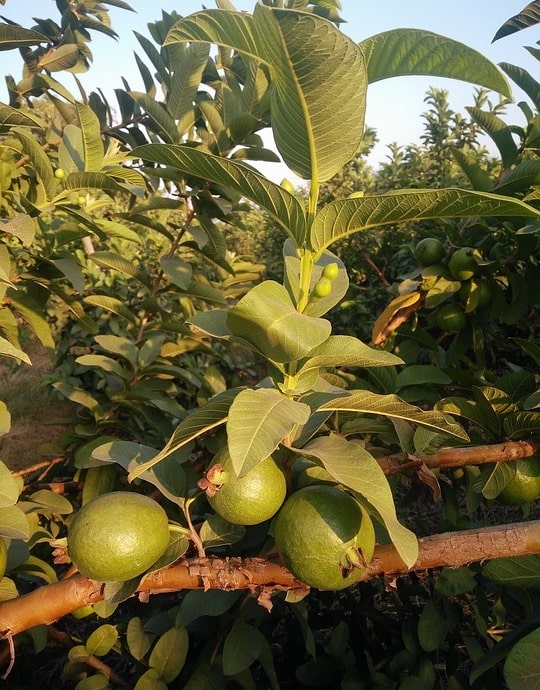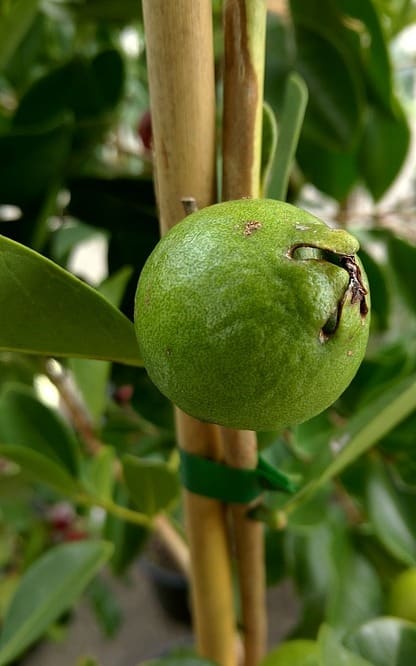Guava Grafting Methods, Pruning Procedure, and Training
Today, we are into guava grafting methods, pruning procedures,s, and training.
The guava tree which is scientifically called Psidium Guajava L is a tree that is mostly seen and survives in tropical areas like South America, India, Philippines. The guava tree will grow to a height which is average of 32 feet and the fruits which the guava tree produces will be sweet and their odor will be musky. If you are into Guava Farming, you must know about the guava grafting process.
Grafting a Guava tree:
- Patch budding is the most common technique for grafting guava trees. While grafting a guava tree, as a first step, you will need to choose an upright and strong specimen required for your rootstock.
- This particular section of your grafted guava plant will give it the structural strength for your section of fruiting. Graft the guava tree at the time of the active growing season., that is when your guava trees have many numbers leaf buds.
- Clean the area at which you work with a solution that acts as a mild disinfectant.
- The solution should contain one section of chlorine bleach added with nine sections of water. Wipe the grafting tools and the countertop with this disinfectant solution for the prevention of entering of bacteria and the organisms which cause diseases into your graft.
- Now cut off any sort of bud specimen from the scion of the tree. The scion is a section of the graft which leads to the formation of foliage and fruits on the guava trees which are being propagated.
- Choose an area of the bark which consists of a healthy and a new branch bud and has almost the same kind of thickness as the bark which is on the rootstock which you have selected. Make use of a sharp knife to remove the new branch bud.
- Cut through the bark and also around the bud which is selected which would create a shape of a rectangle and includes between a half-inch and two inches of bark surrounding the adjacent sides of the bud which is young.
- Slicing through the barks layer will release a section that consists of the bud. A damp paper towel can be laid on the bark which is detached and the bud in order to maintain moisture.
- Slice a section of bark from the specimen of your rootstock, approximately 3 feet from the ground. Remove a small portion of the bark which matches the shape and size of the scion. Peel the bark so that the inner stem will be exposed.
- Fit in the bark segment which consists of the leaf bud into the wound which you have created in the bark of the rootstock. Press the patch of the bark in a firm manner in place. Cover the lower and upper sections of the patch of the bark with the help of the grafting tape by exposing the leaf bud to the air.
- Keep watering the guava tree on a regular basis in order to keep the soil moist all along the area of the roots. Keep watching for the growth to appear in the scion which has been grafted.
- This growth is the sign that the graft is successful. Remove the upper section of the specimen of the rootstock after the bud which is grafted produces at least 4 inches of growth.

Pruning a Guava tree:
Guava is a tree that is shrubby and grows in a dense manner. This tree will grow horizontally across the ground. Hence, select pruning the guavas in the shape of a bush or tree, or you can even grow them as a hedge. If pruning of guava tree is done in the form of a bush, emerging of branches will be done two feet from the ground. In either of the cases, it is always better not to let your guava grow taller than 9 feet. If grown, this would blow away at the time of strong winds.

There are three types of cuts that are used on the trees of guava:
- Thinning cuts
- Heading back
- Pinching
- Thinning will help to act against the dense growth of the tree in order to allow air and light into the inner branches. This will help the branches to stay healthy and also productive.
- This will also make it easy to reach the fruit. For thinning, you need to first remove a few of the branches by slicing them at their base.
- Pinching will remove the tips of the shoots which are growing.
- Heading back means nothing but the pruning of the individual branches in order to decrease the length.
- The above techniques will let you control the tree from spreading horizontally. Guava will start flowering on the new growth. Hence these cuts will also induce the tree for producing more and more flowers along with fruits.
- It is very much necessary to prune the trees which are established on a regular basis for the prevention of spreading away from the actual location of planting.
- Guavas are the trees that have become invasive in the regions like Hawaii, Florida, or any other location. Take off any suckets which will appear at the tree base or above the roots and cut the branches which have spread very far.
- Pruning of Guava trees should be done three months after plantation for training them to the desired shape. If you are pruning your guava tree in the shape of a tree, you need to choose a single trunk and at least 4 lateral branches.
- Take off all the other shoots. Pinch the tips of the chosen lateral branches when they are three feet in terms of length. This will make them produce a number of branches.
- After pinching, start pruning your guava tree every year for the maintenance of its symmetry and remove any sort of growth that is found to be excess.
- The pruning of the guava tree should be performed at the time of late winter or in the early times of spring. The branches and suckers which have been diseases can be taken off at any time of the year.
- The commercial farmers will do severe crop cycling pruning in order to postpone fruiting in the individual trees in the upcoming season. This particular practice will let the plantation to produce fruit for longer periods of time.
In case if you miss this: Lemon Tree Pruning Methods.
Training a guava tree:

- When you are growing a guava tree, it is sometimes very much necessary to train the guava tree in a particular shape for the encouragement of the lateral growth, make it much simple for the fruit harvest, and stop them from overgrowing the space which they occupy.
- Allowing a guava tree to grow too tall is very dangerous for the tree as it would not be stable to stand up in the time of bad weather and strong winds which may even uproot the tree. The type of training which is required will change as the tree starts maturing.
- Start pruning the guava tree when it reaches the height of approximately two feet in order to encourage the growth of the lateral branches. As these lateral branches start growing, remove the tips of some of the branches once they reach the length of three feet approximately. Remove the tips of the branches which are raising from the tips once they reach the length of three feet.
- Cut any of the shoots or branches which are not necessary for the trunk. The tree must be kept small pruning the top and ends of the tree continuously.
- Make a canopy with the shape of a circle by putting the branches trimmed to an almost same radius around the trunk of the tree.
- The tree will keep working at its best if its height is between 4 to 10 feet. Any tree which is taller than 10 feet will go through tipping.
- Start pruning the branches which are injured or dead in order to keep the tree away from the disease. Prune the branches which are overlapping to keep the canopy from becoming heavier.
In case if you are interested in this: Onion Growing Tips, Tricks, and Secretes.
- Types of Pesticides Used in Agriculture: A Beginner’s Guide
- Economical Aquaculture: A Guide to Low-Budget Fish Farming
- 15 Common Planting Errors That Can Doom Your Fruit Trees
- How to Make Houseplants Bushy: Effective Tips and Ideas
- Innovative Strategies for Boosting Coconut Pollination and Yield
- Pollination Strategies for Maximum Pumpkin Yield
- The Complete Guide to Chicken Fattening: Strategies for Maximum Growth
- Natural Solutions for Tulip Problems: 100% Effective Remedies for Leaf and Bulb-Related Issues
- Revolutionizing Citrus Preservation: Towards a Healthier, Greener Future
- Natural Solutions for Peony Leaf and Flower Problems: 100% Effective Remedies
- Maximizing Profits with Avocado Contract Farming in India: A Comprehensive Guide
- Natural Solutions for Hydrangea Problems: 100% Effective Remedies for Leaf and Flowers
- The Ultimate Guide to Choosing the Perfect Foliage Friend: Bringing Life Indoors
- From Sunlight to Sustainability: 15 Ways to Use Solar Technology in Agriculture
- The Ultimate Guide to Dong Tao Chicken: Exploring from History to Raising
- The Eco-Friendly Makeover: How to Convert Your Unused Swimming Pool into a Fish Pond
- Mastering the Art of Delaware Chicken Farming: Essentials for Healthy Backyard Flocks
- 20 Best Homemade Fertilizers for Money Plant: DIY Recipes and Application Methods
- How to Craft a Comprehensive Free-Range Chicken Farming Business Plan
- Brighten Your Flock: Raising Easter Egger Chickens for Beauty and Bounty
- How to Optimize Your Poultry Egg Farm Business Plan with These Strategies
- Subsidy for Spirulina Cultivation: How Indian Government Schemes Encouraging Spirulina Farmers
- Ultimate Guide to Raising Dominique Chickens: Breeding, Feeding, Egg-Production, and Care
- Mastering the Art of Raising Jersey Giant Chickens: Care, Feeding, and More
- Ultimate Guide to Raising Legbar Chickens: Breeding, Farming Practices, Diet, Egg-Production
- How to Raise Welsummer Chickens: A Comprehensive Guide for Beginners
- How to Protect Indoor Plants in Winter: A Comprehensive Guide